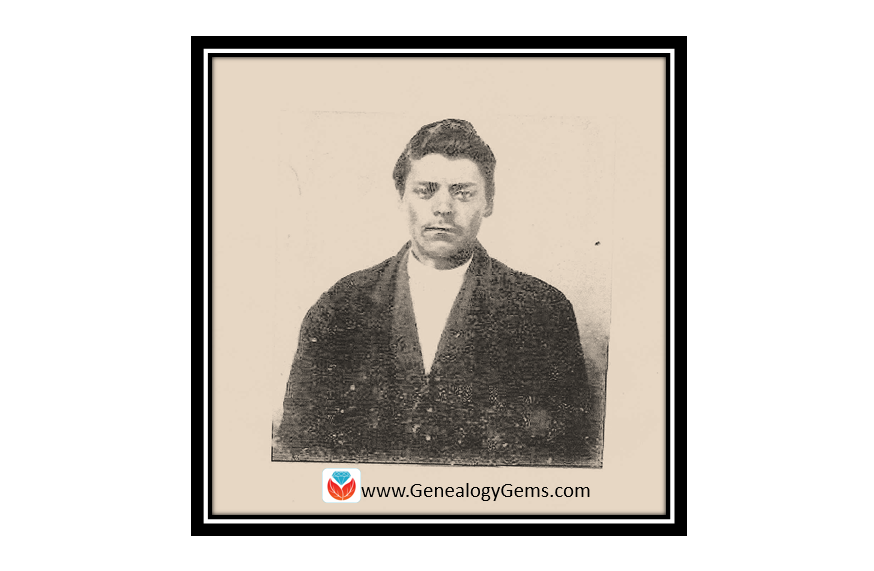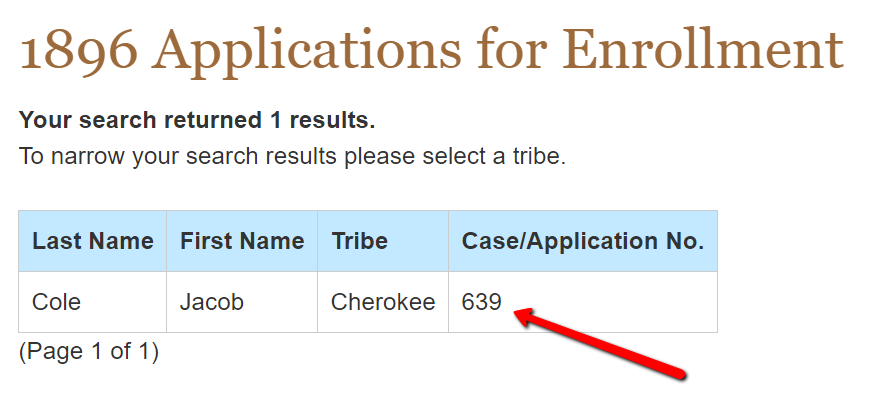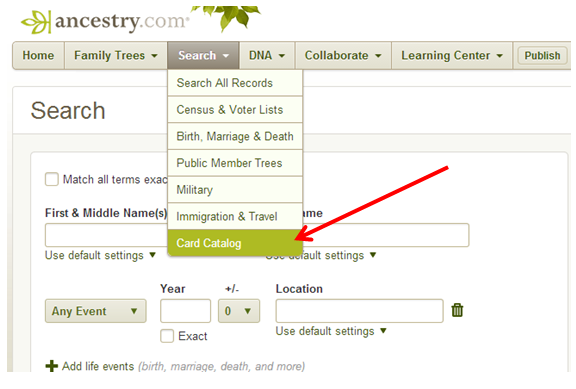Here are the step-by-step instructions you need to know to effectively navigate the Dawes Applications for Native American research. Many American families have a tradition of Native American ancestry. Now through Nov. 15, 2016 Fold3 has made access to their Native American records collections free. Read on to gain a thorough knowledge of how to properly use these records and achieve research success! And sign up for our free Genealogy Gems newsletter for our upcoming posts on this important subject.

Dawes Applications for Native American Research
In 1893, an act of Congress approved the establishment of a commission to negotiate agreements with the Choctaw, Creek, Chickasaw, Seminole, and Cherokee Indian tribes. The commission became known as the Dawes commission. The commission was to divide tribal land into plots, which were then divided among the members of the tribe. The Commission either accepted or rejected applicants for tribal membership based on whether the tribal government had previously recognized the applicant as a member of the tribe. Applicants were categorized as Citizens by Blood, Citizens by Marriage, Minor Citizens by Blood, New Born Citizens by Blood, Freedmen (African Americans formerly enslaved by tribal members,) New Born Freedmen, and Minor Freedman.
Researching the Dawes Packets is tricky. One problem arises when researchers find their family members in an index and assume that means their family was a legitimate member of a tribe. That is not the case. You will find doubtful or even rejected applications as well.
The good news is that in applying, our ancestors provided lots of genealogically valuable details of their birth, residences, and family ties.
Let’s see how to use this special collection.
Dawes Packets are Listed By Application Number
It would take forever to go through the applications one by one to find your ancestor. You really need to check an index first, but Fold3 doesn’t have the index for the Dawes Packets collection available…at least as far as I have found.
Instead, I would suggest going over to Ancestry.com. There, click on Search and choose Card Catalog from the pull-down menu. In the keyword search at the card catalog, type in Five Civilized Tribes. This will give you the option of several databases, but the one we want to check first is the one titled “U.S., Native American Applications for Enrollment in Five Civilized Tribes, 1898-1914.”
Now, search for your targeted ancestor by name. In my example, I am going to search for David O. Scott.

The results indicate that David O. Scott appears in two entries. One entry gives the number of #9446 and the other is #616. I can view each of these records directly from Ancestry. The first image you see is a jacket cover, so just click the right arrow key to scroll through the digital pages contained in David’s file.
Remember, if you don’t have access to Ancestry.com, many local libraries and family history centers have free access for patrons. But, we are talking about using Fold3, so let’s pop back over there.
Go back to Fold3.com to access their Native American records. You will do this by clicking on Browse at the top of the Fold3 homepage. Next, scroll through the options and choose Non-Military Records. A new list of options will appear and you will click on Native American Collections, then Dawes Packets. The Dawes Packets that appear here on Fold3.com are first broke down into tribe, then by number.

David O. Scott’s search on Ancestry listed him as Cherokee, so I want to choose that tribe. One of his numbers was #616.

Did you notice the numbers have a “D” in front of them? These are the applications deemed “doubtful.” If you scroll down, the letter changes to “R.” These applications were rejected. We don’t know if David’s number 616 is in the doubtful category or the rejected category, so we will check both.
David’s #616 matches the D616 and now I know that his application was marked doubtful. David’s pages of information were packed with genealogical detail like family names, dates, and residences.
The 1896 Applications
Here’s another tip: Your ancestor may have applied in the first wave of applications submitted in 1896. Those applications were later deemed invalid and thrown out, but wow…you don’t want to overlook them! Whether your ancestor applied again in 1898 and you already found their Dawes Packet on Fold3, try looking at this collection as well.
The research center at the Oklahoma Historical Society webpage allows you to search the 1896 overturned applications index for free. I typed in the name of my third great-grandfather, Jacob Cole.

You can also search by tribe, however, I suggest you do not do that. Sometimes, individuals actually applied to more than one tribe because they were not sure which tribe they might belong to. By adding that criteria, you may miss your ancestor’s application all together.
Only one result appeared for Jacob Cole. On this result, you notice the tribe affiliation as Cherokee and the case/application number of 639. I will need that tribe and number to find the application at Fold3. [Note: As I mentioned earlier, this index does not tell me if Jacob’s application was accepted or rejected, but it really doesn’t matter because these applications were deemed invalid anyway.]

You won’t find Jacob’s overturned application of 1896 on Fold3 at this time, but it is available at Ancestry.
Where Can I find Overturned Applications for 1896?
Overturned applications from 1896 are still very valuable records. They can be found at the National Archives and Records Administration in Washington D.C., or at Ancestry.com.
Let’s look at Ancestry. Once at the homepage, click Search at the top, then choose Card Catalog from the pull-down options.
 In the keyword field on the right, type in Five civilized tribes. You will see many options, but you want to click on the collection titled “U.S. Native American Applications for Enrollment in Five Civilized Tribes (overturned,) 1896.”
In the keyword field on the right, type in Five civilized tribes. You will see many options, but you want to click on the collection titled “U.S. Native American Applications for Enrollment in Five Civilized Tribes (overturned,) 1896.”

This next step is a bit tricky. You will be directed to a page that allows you to seemingly search for your targeted ancestor’s application. But, the search only searches an index for the applications. To find the entire application packet, you need to browse the microfilm by hand.
To do that, look over to the far right where it says Browse this collection. Choose from the drop-down menu which tribe your ancestor applied to…so, I will choose Cherokee Applications. Then, choose the roll number based on the application number of the packet. I can determine the correct roll number because Jacob’s application number was 639 and Roll 25 includes all applications between the numbers of 486 and 681.

Click ALL and a digital image of the microfilm pops up. You will need to browse image-by-image until you find your ancestor’s application number. Be patient. With more than 1800 images, it will take some time.
[Special Note: On the very last roll of microfilm, Roll 54, there are some miscellaneous files and applications that were received past the application deadline. These records were not included in the Master Index. If you did not find your targeted ancestor in the Master Index, check these miscellaneous records.]I found Jacob’s application on digital image number 1405. His application packet was nine pages long. I learned the ages and names of his current wife and children, how he believes he is Cherokee through the blood of his grandfather, Hawk Bowman, and I read two witness statements about Jacob and his family.
In particular, because this record was made in the 1890s, I was able to learn of two daughters that I had never known about. Martha had been born after the 1880 census and married before 1900, never having appeared with her father in a census. The second daughter, Mary J., had been born in 1895 and died before 1900, also never appearing with her family in a census record.
More on Native American Research
We will be creating further blog posts regarding each of the Native American collection sets at Fold3.com. We want you to be able to take advantage of this awesome opportunity to view the records for free for this limited time. In the meantime, be sure to read this how-to post on using Eastern Cherokee Applications: Eastern Cherokee Applications for Native American Research
Disclosure: This article contains affiliate links and Genealogy Gems will be compensated if you make a purchase after clicking on these links (at no additional cost to you). Thank you for supporting Genealogy Gems!





Thank you, Amy, for explaining how to use the Dawes Collections. If only there was a similar database for New England native peoples!
There is one HUGE error in this post. The rejected applications ARE part of the Fold 3 and Ancestry collections. That’s why they have a D, for doubtful, or R, for rejected. Also, a huge opportunity is being missed by not instructing readers to view the actual Dawes Application Cards. For Freedmen, these cards can have upwards of 3 generations of information, including the names of former slaveholders.
I’m the future, I highly suggest getting information vetted by someone who has more knowledge on the issue. This is not only problematic but also speaks to the already existing culture within genealogy to be an “expert” when it comes to minority populations after picking up minor skills.
Love this, Amy.I too want to say Thank You for sharing this. And I love that you explained each step of the processfor us to follow. That really was very helpful in learning “the right way” to go about trying to find you Native American history. THANKS AGAIN.
Sharon, You are very welcome! I am so pleased it was helpful to you!
It is important to understand that the Five Civilized Tribes—Cherokee, Choctaw, Chickasaw, Creek and Seminole nations were never on “reservations”. They were sovereign nations and had tribal councils, courts and constitutions, as they still do today.
Dawes enrollees also had CLEAR knowledge of the tribe to which they belonged. They lived under the laws of their respective nation, spoke the language of their nation, and they had to provide evidence of their affiliation to the tribe.
Most importantly—the index to the 1896 roll in the article is NOT the index to the Dawes Roll. The correct searchable index to the Dawes Roll provided by the Oklahoma Historical Society is: http://www.okhistory.org/research/dawes
The most critical documents are: Dawes Card, Application Jackets and Allotment applications. The Final Rolls comprise he 600+ page document used as the “base” roll for enrollment today.
The documents and items presented in the article do not reflect the real Dawes search. I will be developing a more detailed article on my blog that you can later share with your readers about using Dawes records.
Note that Mississippi Choctaws are the only “eastern” group included in the Dawes records, with full applications, and enrollment cards. However, it should be clearly pointed out that one will not find applications from tribes on the eastern states among Dawes records.
And please note again–that the nations were never “reservations”.
I would like to address some of the concerns expressed regarding this post. First, it was my intention to remain true to our purpose here at Genealogy Gems, which is to encourage people, no matter their level of genealogical experience, to feel comfortable and empowered to search new things for the purpose of family history. I used a specific example to illustrate the point that even if we find our ancestors were rejected, these unique records helped me in my own family research to find proof of parentage for Martha and Mary J. as daughters of Jacob Cole. Even though Jacob and many of my other family members do not appear on the Final Dawes Rolls, finding their Dawes applications have been a treasured find.
One comment included this statement, “Most importantly—the index to the 1896 roll in the article is NOT the index to the Dawes Roll. The correct searchable index to the Dawes Roll provided by the Oklahoma Historical Society is: http://www.okhistory.org/research/dawes.” This is correct. The link I provided to the Oklahoma Historical Society was the index to the overturned, 1896 applications and does not correspond with the Dawes Packets available at Fold3. The link provided by the commenter, http:www.okhistory.org/research/dawes, is the link to an index to the Final Dawes Rolls and will also not necessarily correspond with the Dawes Packets on Fold3.
So for our readers out there…it is a great idea to actually check three different indexes: the 1896 Applicants for Enrollment index at Oklahoma Historical Society, the “U.S., Native American Applications for Enrollment in Five Civilized Tribes, 1898-1914” at Ancestry, and the Dawes Final Rolls index also at Oklahoma Historical Society. In this way, we make sure we find all the possible records on our targeted ancestor for this record set. The important thing is to find valuable genealogical information that helps us fill our pedigree charts and having some documentation to back it up!
It was also mentioned that the “most critical documents” for Dawes research should have been addressed in our post. As you know, we plan on writing more posts about each of the record sets in the Native American collections available from Fold3 and in those additional posts, we will be discussing the census/enrollment cards and application jackets as some have mentioned. Sign up for our free newsletter so you don’t miss them!
Regarding Choctaw. Though I am unsure of what our commenter meant by the reference to “Mississippi Choctaws are the only eastern group included in the Dawes record, with full applications, and enrollment cards,” I will say this: According to my source provided by the National Archives and Records Administration’s PDF entitled, “The Dawes Rolls (Final Rolls of the Citizens and Freedmen of the Five Civilized Tribes in Indian Territory),” it states:
“Only a portion of the census cards are described online, and none for the Choctaw. If you are looking for a Choctaw, you may still want to do the online search since there may be records online for an 1896 application.” The link for that source is: https://www.archives.gov/files/research/native-americans/dawes/dawes-how-to.pdf, page 4.
According to this reputable source, it seems that Choctaws have none of their census or enrollment cards online. It is further suggested that those searching for Choctaw ancestors should use the 1896 applications, which we used in this post.
Lastly, I want to appropriately comment to the statement regarding my “minor skills” in regards to a minority population. Friends, my ancestry takes me through over 60 years of Native American history and documentation. That same family line intertwines with Free People of Color. I have never claimed to be an expert, but I do feel I have experience and knowledge about these record sets that will benefit our readers and that’s what I am here to do. We are here to share the journey with you and value the unique knowledge that each of us hold.
I think this is a great opportunity to see how working together, we can become more knowledgeable in our genealogy research. I and our Genealogy Gems team are always happy to receive constructive and helpful dialog from you, our readers! Thanks for reading.
trying to find my Great Grandfather, which Tribe that he would belong to
Ann…can you give me a little more information. What was your great-grandfather’s name, birth year, and where did he live most of his life?
I have bee trying to locate the connection to a Cherokee tribe for an Ancestor whose Mother was suppose to be close to full blood Cherokee. Her name is Effie Hargiss, born in Missouri to Napolean Lethet Hargiss, born in Tennessee Son of James Dennis Hargiss and Mary Harrison Linville. Mother of Effie is Alice Victoria Hedrick from North Carolina, daughter of Emanuel Hedrick and Mother was Margaret M Seabaugh or Seapoth.
Effie was married to Charles Cooper, they lived in Missouri. If you can help, let me know.
Sally